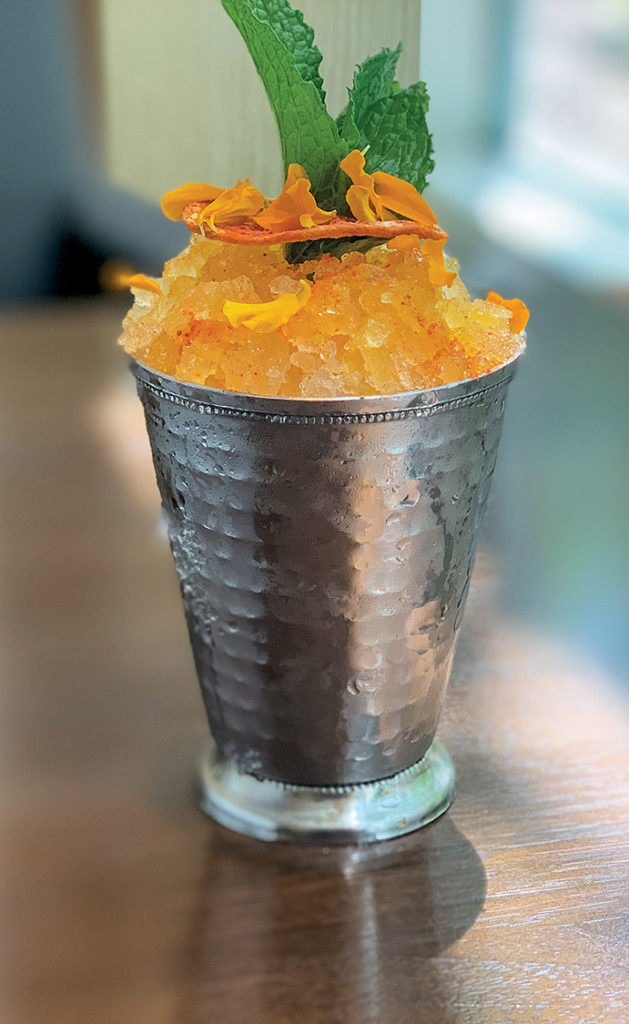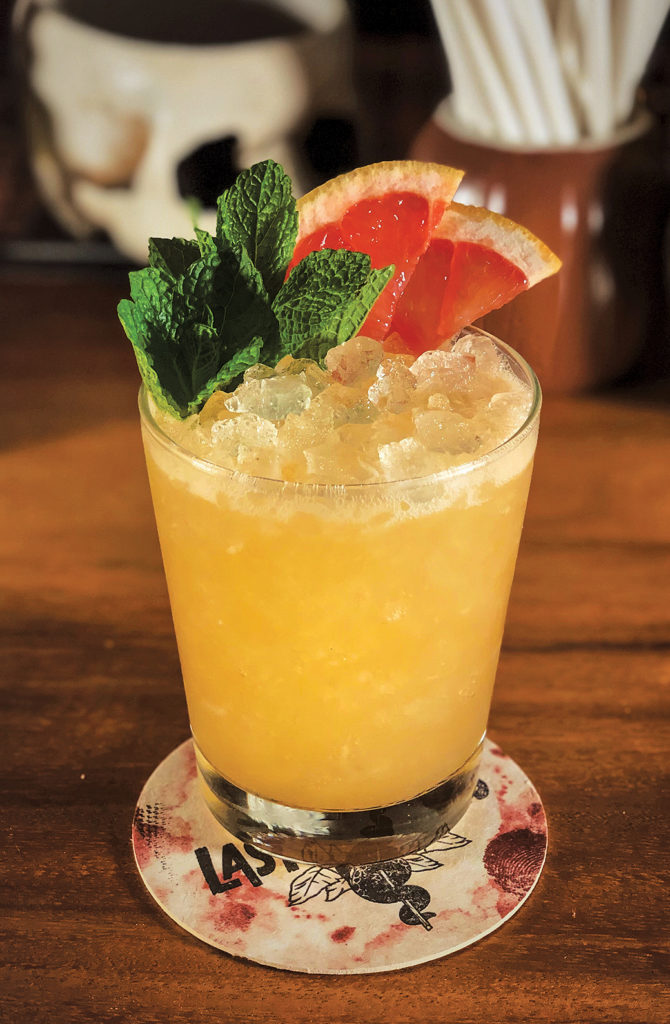Editor’s Note: As so many beverage alcohol trends begin at bars and restaurants, we occasionally cross-post content from our on-premise sister magazine, Cheers.
Mocktails. Non-alcoholic cocktails. Zero-proof libations. Whatever you call them, the modern versions are miles above the sad, lemon-wheel-adorned glass of soda water that non-imbibers used to resign themselves to.
Savvy bartenders understand that no matter guests’ reasoning for abstaining from alcohol, they don’t need to deprive themselves on flavor and a great beverage experience.
David Mor, beverage manager at Cindy’s rooftop restaurant in the Chicago Athletic Association Hotel, began using the term “spiritfree” to describe this category of drinks after reading Chicago bartender Julia Momose’s Spiritfree manifesto. In the manifesto, published in September 2017, Momose actively champions for nonalcoholic cocktails to become a part of more beverage programs.
“Spiritfrees are thoughtfully created, intentionally offered and ultimately satisfying,” Mor says. They should also possess the same hallmarks as any cocktail: balance and inspiration.
When developing no-alohol cocktails, Mor starts by familiarizing himself with high-quality mixers and teas by using them in shrubs, tisanes and syrups. He then lengthens them with soda or another effervescent ingredient. “Once the foundation is set,” he notes, “it’s exciting to find what components might add complexity, additional layers or more powerful flavor.”
Cindy’s has been offering spiritfrees (shown atop) since it opened in 2015, but the staff has noticed a surge in interest since late 2018. The restaurant now dedicates an entire page of the menu to the three non-alcoholic drink options, as well as its diverse coffee and tea program.
The crisp, vegetal Green Earth Farm ($10) tops Fusion verjus blanc and a house-made iceberg lettuce syrup with Fever Tree Mediterranean Tonic, garnished with thyme and nasturtium leaf. The CB+T ($10) mixes Kyoto Black cold-brew coffee with cane syrup and Fever Tree Indian Tonic garnished with expressed orange peel. (Mor has worked with Kyoto Black founder Justin Doggett for more than 50 recipes using his cold brew.)
And the Beach Babe ($10) shakes Seedlip Spice 94 with passion fruit cordial, coconut cream, cold-pressed pineapple and lime juices and demerara syrup, finished with grated nutmeg and a mint crown.
Sowing the Seedlip
Seedlip launched in the U.K. in late 2015 as the world’s first distilled, non-alcoholic “spirit.” It arrived in the U.S in early 2017 and has emerged as a go-to base for creative mocktails.
Akin perhaps to a botanical-rich, alcohol-free gin, Seedlip is produced in three expressions that highlight spice (Spice 94), herbal (Garden 108) and citrus (Grove 42) flavor notes.
Boleo, a 165-seat Peruvian and Argentine street fare and cocktail spot in Chicago’s Kimpton Gray Hotel, included a Seedlip libation on its first menu featuring non-alcoholic beverages. The Seeds of Passion ($12) mixes Seedlip Spice 94 with passion fruit puree, verjus rouge, ginger syrup and pineapple juice, topped with soda and adorned with an orchid.
By adding these drinks and their ingredients and descriptions (described as “refreshing libations” on the list), Boleo bar director Josh Relkin has seen an uptick in sales. “It’s also been cool to see that they are not ordering just one, but going through what we have on the menu and even requesting us to make up a dealer’s choice style drink for them,” Relkin notes.
“Products like Seedlip offer a great base for a no-proof cocktail, but they can also be used as an accent—like aromatic bitters,” says Troy Smith, the beverage manager of Montage Laguna Beach. The California hotel with several dining concepts, including the 102-seat Patio, has recently rolled out no-proof sips with hopes of attracting more attention from guests.
The Lemon Thyme ($12) combine Seedlip Grove 42, lemon juice, simple syrup, soda and lemon thyme harvested from an on-site garden adjacent to the cabanas that does double duty as a privacy shrub. The heady and delicate Garden Cooler ($12) uses elderflower syrup, basil and lemon, topped with club soda. Because these drinks are ever-changing due to the availability of garden produce, servers and bartenders promote them verbally rather than printing them on the menu.
Seasonal sensations
Salazar, a 135-seat restaurant in Los Angeles specializing in mesquite grill-cooked cuisine, also depends on seasonal fruit for its agua frescas—light fruit drinks popular in Mexico. The highlight of Salazar’s non-alcoholic drink program since their inception, the agua frescas come in varieties including watermelon and peach and are dispensed from a machine behind the bar.
The basic recipe for agua frescas is straightforward, according to bar coordinator Adam Maldonado: “Fresh seasonal fruit (pureed is preferred over juiced) and a balance of acid (citrus), salt and sweet,” he explains. “Salt is the secret ingredient, it’s often overlooked in making drinks, but it really ties sugar and citrus together.”
Tulio, an urbane Italian restaurant in downtown Seattle, also strives to use produce that’s at its peak for its mocktails. The Rainier Cherry Shrub ($13) created by beverage manager Jordan Craig-Wood, shakes grapefruit juice and Champagne vinegar with a house-made Rainier cherry syrup. (Rainier, a cross between Bing and Van cherry, is fleetingly available during Pacific Northwest summers.) “The drink was inspired by wanting to utilize the delicious, well-loved summer fruit while supporting local farmers.”

The Lemon Lavender Tini ($13) combines lemonade with lavender and grenadine syrup, and the Hibiscus Lime Spritz ($12), made with lime juice and house-made hibiscus syrup, is tangy, earthy, sweet and refreshing, Craig-Wood says.
Every drink at Tulio regardless of its base receives the same attention. “We feature [the non-alcoholic drinks] right next to our house cocktails [and] taste the entire staff on them like we do all our other cocktails,” says Craig-Wood.

The same holds true at Blue Duck Tavern in Washington, D.C.’s West End. For example, Blue Duck makes its Pineapple and Passionfruit Julep ($12) by fermenting pineapple for a minimum of 14 days before blending it with passion fruit puree and Fresno peppers. The glass is rimmed with li hing powder, a Hawaiian dried plum salt and sugar mixture.
“Fresh ingredients and creative processes to draw the true depth of flavor out of items” are the secrets to great alcohol-free sips, says Blue Duck’s lead bartender Cole Burger. “The time committed to high-quality ingredients and using them in their freshest state will show through in the beverage.”
Tiki for teetotalers
A Tiki-style bar, where several styles of rum—including overproof—are known to go into potent potables in large mugs and bowls, might seem like an unlikely place to have a robust mocktail program. But that’s exactly what guests encounter at Last Rites, a 49-seat bar in San Francisco that’s inspired by Polynesian Noir and creates the experience of being marooned in a tropical jungle.
The mid-century menu was peppered with strong layered rum drinks, but staff realized that while that might fly on festive Friday and Saturday nights, they wanted to provide tamer options, especially for weeknights. Last Rites launched “No ABV” and “Low ABV” sections to the menu this past March.
The challenge, says bar manager Susan Eggett, was making sure that these beverages still fit in with the bar’s narrative. “They [needed to] possess the same rich and complex flavor combinations…garnished in our style and just so happen to have less—or no—alcohol,” she says. “The goal was for these drinks to not feel like an afterthought, but be just as ‘cravable’ as the other drinks.”

Last Rites turned to its stocked arsenal of fresh juices and interesting syrups for sips such as The Golden Idol ($8), with lemon, orange and pineapple juices, coconut cream, golden turmeric syrup and soda. The Little Mule ($8) combines yerba-mate-spiced honey, fresh ginger juice, grapefruit, lime, soda and a dash of bitters.
Texture and mouthfeel can be lacking from with no-ABV drinks, Eggett says, because alcohol adds weight and body; other ingredients with similar viscosity can be substituted.
But while the alcohol is absent, the service shouldn’t be. “A guest should receive the same experience of watching the cocktail being built, and it should also be beautifully garnished and served in the same glassware,” Eggett says.
What’s more, not only do many of the names for mocktailsgive the impression that they lacking something, many operators fail to market their no-alcohol selections on the menu in an inviting and interesting way.
The Center Bar and the 210-seat Porter House Bar and Grill in The Shops at Columbus Circle in New York has a clever solution for promoting these offerings.
“We use the term ‘Prohibition Cocktails,’ because it addresses the situation in a classy way without making people feel uncomfortable,” says beverage director Adam Petronzio. “You shouldn’t miss the alcohol—you should still feel like you’re having an adult drink in an adult environment.”
Kelly Magyarics, DWS, is a wine, spirits, travel and lifestyle writer in the Washington, D.C. area.





[…] study, 58% of consumers are drinking more no-and low-abv drinks than last year, and 55% of the most influential bartenders in New York, Los Angeles and London believe the no-and low-alcohol trend will continue to […]